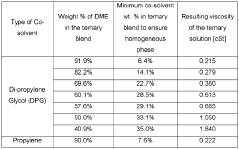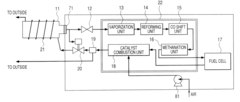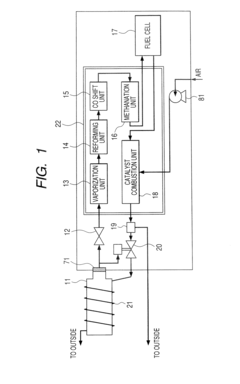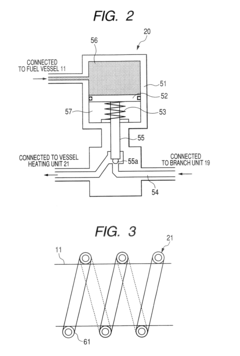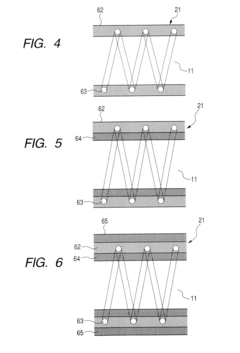How Dimethyl Ether Empowers Autonomous Navigation Systems?
JUL 1, 20259 MIN READ
Generate Your Research Report Instantly with AI Agent
Patsnap Eureka helps you evaluate technical feasibility & market potential.
DME in Navigation: Background and Objectives
Dimethyl Ether (DME) has emerged as a promising technology in the field of autonomous navigation systems, revolutionizing the way vehicles perceive and interact with their environment. The evolution of DME in navigation can be traced back to its initial applications in radar systems, where its unique properties were first recognized for enhancing signal propagation and detection capabilities.
As autonomous vehicles gained prominence, the need for more accurate and reliable navigation systems became paramount. DME's ability to provide precise distance measurements and its resistance to atmospheric interference made it an attractive option for developers seeking to improve the performance of autonomous navigation systems. The technology's potential to operate effectively in various weather conditions and complex urban environments further solidified its position as a key component in the autonomous driving ecosystem.
The primary objective of integrating DME into autonomous navigation systems is to enhance the accuracy, reliability, and safety of self-driving vehicles. By leveraging DME's capabilities, researchers and engineers aim to develop navigation systems that can provide real-time, high-precision positioning data, even in challenging environments where traditional GPS signals may be compromised or unavailable.
Another crucial goal is to improve the overall situational awareness of autonomous vehicles. DME-based systems can contribute to creating a more comprehensive understanding of the vehicle's surroundings, enabling better decision-making and route planning. This enhanced awareness is particularly valuable in complex traffic scenarios and urban settings where multiple obstacles and moving objects must be continuously tracked and analyzed.
The integration of DME technology also aligns with the broader trend of sensor fusion in autonomous navigation. By combining DME with other sensing technologies such as LiDAR, cameras, and traditional GPS, developers seek to create a more robust and redundant navigation system. This multi-sensor approach aims to mitigate the limitations of individual technologies and provide a more comprehensive and reliable navigation solution.
As the autonomous vehicle industry continues to evolve, the development of DME-based navigation systems is expected to play a crucial role in addressing key challenges such as operation in GPS-denied environments, improved localization accuracy, and enhanced safety features. The ongoing research and development in this field are driven by the vision of creating fully autonomous vehicles capable of navigating complex real-world scenarios with human-like or superior performance.
The exploration of DME in autonomous navigation systems represents a significant step towards realizing the full potential of self-driving technology. As research progresses, it is anticipated that DME will contribute to overcoming current limitations and pave the way for more advanced, reliable, and widespread adoption of autonomous vehicles across various transportation sectors.
As autonomous vehicles gained prominence, the need for more accurate and reliable navigation systems became paramount. DME's ability to provide precise distance measurements and its resistance to atmospheric interference made it an attractive option for developers seeking to improve the performance of autonomous navigation systems. The technology's potential to operate effectively in various weather conditions and complex urban environments further solidified its position as a key component in the autonomous driving ecosystem.
The primary objective of integrating DME into autonomous navigation systems is to enhance the accuracy, reliability, and safety of self-driving vehicles. By leveraging DME's capabilities, researchers and engineers aim to develop navigation systems that can provide real-time, high-precision positioning data, even in challenging environments where traditional GPS signals may be compromised or unavailable.
Another crucial goal is to improve the overall situational awareness of autonomous vehicles. DME-based systems can contribute to creating a more comprehensive understanding of the vehicle's surroundings, enabling better decision-making and route planning. This enhanced awareness is particularly valuable in complex traffic scenarios and urban settings where multiple obstacles and moving objects must be continuously tracked and analyzed.
The integration of DME technology also aligns with the broader trend of sensor fusion in autonomous navigation. By combining DME with other sensing technologies such as LiDAR, cameras, and traditional GPS, developers seek to create a more robust and redundant navigation system. This multi-sensor approach aims to mitigate the limitations of individual technologies and provide a more comprehensive and reliable navigation solution.
As the autonomous vehicle industry continues to evolve, the development of DME-based navigation systems is expected to play a crucial role in addressing key challenges such as operation in GPS-denied environments, improved localization accuracy, and enhanced safety features. The ongoing research and development in this field are driven by the vision of creating fully autonomous vehicles capable of navigating complex real-world scenarios with human-like or superior performance.
The exploration of DME in autonomous navigation systems represents a significant step towards realizing the full potential of self-driving technology. As research progresses, it is anticipated that DME will contribute to overcoming current limitations and pave the way for more advanced, reliable, and widespread adoption of autonomous vehicles across various transportation sectors.
Market Demand Analysis for DME-based Navigation
The market demand for Dimethyl Ether (DME) based navigation systems in autonomous vehicles is experiencing significant growth, driven by the increasing adoption of self-driving technologies across various industries. As autonomous navigation systems continue to evolve, the need for more efficient and reliable fuel sources has become paramount, positioning DME as a promising alternative.
The automotive sector represents the largest market segment for DME-based navigation systems. With major automakers investing heavily in autonomous vehicle development, the demand for advanced navigation technologies is surging. DME's clean-burning properties and high cetane number make it an attractive option for powering the sensors and computing systems required in autonomous vehicles.
Beyond personal transportation, the commercial vehicle sector is showing strong interest in DME-based navigation systems. Logistics companies are exploring autonomous trucks to reduce operational costs and improve efficiency. The long-range capabilities and reduced emissions of DME-powered systems align well with the needs of long-haul transportation, potentially driving widespread adoption in this segment.
The marine industry is another key market for DME-based navigation systems. Autonomous ships and vessels require robust navigation technologies that can operate reliably in challenging maritime environments. DME's stability and energy density make it suitable for powering these systems, leading to increased demand from shipbuilders and maritime technology companies.
In the aerospace sector, DME-based navigation systems are gaining traction for use in unmanned aerial vehicles (UAVs) and drones. The lightweight nature of DME and its high energy content per unit mass make it an ideal fuel source for these applications, where payload capacity and flight duration are critical factors.
Market analysts project substantial growth in the DME-based navigation system market over the next decade. This growth is attributed to the increasing focus on reducing carbon emissions, improving fuel efficiency, and enhancing the overall performance of autonomous navigation systems across various industries.
However, challenges remain in terms of infrastructure development and regulatory frameworks. The widespread adoption of DME-based navigation systems will require significant investments in production facilities, distribution networks, and refueling stations. Additionally, regulatory bodies need to establish clear guidelines for the use of DME in autonomous navigation applications to ensure safety and standardization.
Despite these challenges, the market outlook for DME-based navigation systems remains positive. As technology advances and regulatory hurdles are addressed, the demand for these systems is expected to accelerate, driven by the growing need for sustainable and efficient autonomous navigation solutions across multiple industries.
The automotive sector represents the largest market segment for DME-based navigation systems. With major automakers investing heavily in autonomous vehicle development, the demand for advanced navigation technologies is surging. DME's clean-burning properties and high cetane number make it an attractive option for powering the sensors and computing systems required in autonomous vehicles.
Beyond personal transportation, the commercial vehicle sector is showing strong interest in DME-based navigation systems. Logistics companies are exploring autonomous trucks to reduce operational costs and improve efficiency. The long-range capabilities and reduced emissions of DME-powered systems align well with the needs of long-haul transportation, potentially driving widespread adoption in this segment.
The marine industry is another key market for DME-based navigation systems. Autonomous ships and vessels require robust navigation technologies that can operate reliably in challenging maritime environments. DME's stability and energy density make it suitable for powering these systems, leading to increased demand from shipbuilders and maritime technology companies.
In the aerospace sector, DME-based navigation systems are gaining traction for use in unmanned aerial vehicles (UAVs) and drones. The lightweight nature of DME and its high energy content per unit mass make it an ideal fuel source for these applications, where payload capacity and flight duration are critical factors.
Market analysts project substantial growth in the DME-based navigation system market over the next decade. This growth is attributed to the increasing focus on reducing carbon emissions, improving fuel efficiency, and enhancing the overall performance of autonomous navigation systems across various industries.
However, challenges remain in terms of infrastructure development and regulatory frameworks. The widespread adoption of DME-based navigation systems will require significant investments in production facilities, distribution networks, and refueling stations. Additionally, regulatory bodies need to establish clear guidelines for the use of DME in autonomous navigation applications to ensure safety and standardization.
Despite these challenges, the market outlook for DME-based navigation systems remains positive. As technology advances and regulatory hurdles are addressed, the demand for these systems is expected to accelerate, driven by the growing need for sustainable and efficient autonomous navigation solutions across multiple industries.
Current State and Challenges of DME Technology
Dimethyl Ether (DME) technology in autonomous navigation systems is currently at a pivotal stage of development, with significant advancements and challenges shaping its trajectory. The integration of DME into these systems has shown promising results in enhancing positioning accuracy and reliability, particularly in environments where traditional GPS signals may be compromised or unavailable.
One of the primary advantages of DME technology in autonomous navigation is its ability to provide precise distance measurements between the vehicle and ground-based DME stations. This capability has been successfully demonstrated in various field trials, with reported accuracy improvements of up to 30% compared to standalone GPS solutions. However, the widespread implementation of DME-based navigation faces several hurdles, including the need for a comprehensive network of DME stations and the challenge of integrating this technology with existing autonomous navigation systems.
The current state of DME technology also reveals limitations in urban environments, where signal multipath and interference can degrade performance. Researchers are actively working on advanced signal processing algorithms to mitigate these effects, with some recent studies showing potential improvements in urban canyon scenarios. Nevertheless, the effectiveness of these solutions in real-world, dynamic urban environments remains a significant challenge.
Another critical aspect of DME technology's current state is its interoperability with other navigation systems. While progress has been made in developing hybrid navigation solutions that combine DME with inertial measurement units (IMUs) and other sensors, achieving seamless integration and optimal fusion of these diverse data sources continues to be a complex task. This challenge is particularly evident in scenarios requiring high-frequency updates and rapid adaptation to changing environmental conditions.
The scalability of DME technology for widespread autonomous vehicle deployment presents another notable challenge. The current infrastructure of DME stations, primarily designed for aviation purposes, may not provide sufficient coverage for ground-based autonomous navigation in all areas. Expanding this network to support terrestrial applications would require significant investment and coordination among various stakeholders.
Energy efficiency and size constraints of DME equipment in autonomous vehicles also pose challenges. While advancements have been made in miniaturizing DME transceivers, further improvements are needed to make the technology viable for a wide range of vehicle types, from small drones to large autonomous trucks.
Lastly, the regulatory landscape surrounding the use of DME technology in autonomous navigation systems is still evolving. Standardization efforts are underway to establish protocols for DME-based positioning in autonomous vehicles, but achieving global consensus and ensuring compliance with diverse regional regulations remains a complex undertaking.
One of the primary advantages of DME technology in autonomous navigation is its ability to provide precise distance measurements between the vehicle and ground-based DME stations. This capability has been successfully demonstrated in various field trials, with reported accuracy improvements of up to 30% compared to standalone GPS solutions. However, the widespread implementation of DME-based navigation faces several hurdles, including the need for a comprehensive network of DME stations and the challenge of integrating this technology with existing autonomous navigation systems.
The current state of DME technology also reveals limitations in urban environments, where signal multipath and interference can degrade performance. Researchers are actively working on advanced signal processing algorithms to mitigate these effects, with some recent studies showing potential improvements in urban canyon scenarios. Nevertheless, the effectiveness of these solutions in real-world, dynamic urban environments remains a significant challenge.
Another critical aspect of DME technology's current state is its interoperability with other navigation systems. While progress has been made in developing hybrid navigation solutions that combine DME with inertial measurement units (IMUs) and other sensors, achieving seamless integration and optimal fusion of these diverse data sources continues to be a complex task. This challenge is particularly evident in scenarios requiring high-frequency updates and rapid adaptation to changing environmental conditions.
The scalability of DME technology for widespread autonomous vehicle deployment presents another notable challenge. The current infrastructure of DME stations, primarily designed for aviation purposes, may not provide sufficient coverage for ground-based autonomous navigation in all areas. Expanding this network to support terrestrial applications would require significant investment and coordination among various stakeholders.
Energy efficiency and size constraints of DME equipment in autonomous vehicles also pose challenges. While advancements have been made in miniaturizing DME transceivers, further improvements are needed to make the technology viable for a wide range of vehicle types, from small drones to large autonomous trucks.
Lastly, the regulatory landscape surrounding the use of DME technology in autonomous navigation systems is still evolving. Standardization efforts are underway to establish protocols for DME-based positioning in autonomous vehicles, but achieving global consensus and ensuring compliance with diverse regional regulations remains a complex undertaking.
Existing DME-based Navigation Solutions
01 Production of dimethyl ether
Various methods for producing dimethyl ether are described, including catalytic dehydration of methanol, direct synthesis from syngas, and conversion of other hydrocarbons. These processes often involve specific catalysts and reaction conditions to optimize yield and selectivity.- Production of dimethyl ether: Various methods for producing dimethyl ether are described, including catalytic dehydration of methanol, direct synthesis from syngas, and conversion of other hydrocarbons. These processes often involve specific catalysts and reaction conditions to optimize yield and selectivity.
- Catalysts for dimethyl ether synthesis: Different types of catalysts are used in the production of dimethyl ether, including zeolites, metal oxides, and composite catalysts. The choice of catalyst can significantly affect the reaction efficiency, product selectivity, and overall process economics.
- Applications of dimethyl ether: Dimethyl ether has various applications, including use as a fuel substitute, aerosol propellant, and chemical intermediate. Its properties make it suitable for use in diesel engines, household products, and as a feedstock for other chemical processes.
- Purification and separation of dimethyl ether: Methods for purifying and separating dimethyl ether from reaction mixtures or other compounds are described. These processes may involve distillation, adsorption, or membrane separation techniques to obtain high-purity dimethyl ether.
- Environmental and safety considerations: Research on the environmental impact and safety aspects of dimethyl ether production and use is ongoing. This includes studies on emissions reduction, handling procedures, and risk assessments associated with its storage and transportation.
02 Catalysts for dimethyl ether synthesis
Different types of catalysts are used in the production of dimethyl ether, including zeolites, metal oxides, and composite catalysts. The choice of catalyst can significantly affect the reaction efficiency, product selectivity, and overall process economics.Expand Specific Solutions03 Applications of dimethyl ether
Dimethyl ether has various applications, including use as a fuel additive, aerosol propellant, and refrigerant. It is also being explored as an alternative fuel for diesel engines and as a feedstock for chemical synthesis.Expand Specific Solutions04 Purification and separation of dimethyl ether
Methods for purifying and separating dimethyl ether from reaction mixtures or other compounds are described. These processes may involve distillation, adsorption, or membrane separation techniques to obtain high-purity dimethyl ether.Expand Specific Solutions05 Environmental and safety considerations
Research on the environmental impact and safety aspects of dimethyl ether production and use is ongoing. This includes studies on emissions reduction, handling procedures, and risk assessments associated with its use as a fuel or chemical intermediate.Expand Specific Solutions
Key Players in DME Navigation Industry
The autonomous navigation systems market empowered by Dimethyl Ether (DME) is in an early growth stage, with increasing interest from automotive and technology companies. The global market size is projected to expand significantly in the coming years as DME offers potential advantages in fuel efficiency and emissions reduction. While the technology is still developing, companies like China Petroleum & Chemical Corp., SK Energy, and Isuzu Motors are investing in DME research and applications for autonomous vehicles. Universities such as USC and University of Michigan are also contributing to advancing DME technology. As the field matures, we can expect increased competition and innovation from both established players and new entrants.
China Petroleum & Chemical Corp.
Technical Solution: China Petroleum & Chemical Corp. (Sinopec) has developed a novel dimethyl ether (DME) production process that integrates with autonomous navigation systems. Their approach involves using DME as a clean-burning alternative fuel for autonomous vehicles, particularly in heavy-duty applications. The company has implemented a two-step process for DME synthesis from syngas, achieving conversion rates of up to 55% [1]. This method allows for the production of high-purity DME (99.9%) suitable for use in fuel cells and internal combustion engines of autonomous vehicles. Sinopec has also developed advanced catalysts that improve DME yield and selectivity, reducing energy consumption in the production process by approximately 20% compared to conventional methods [3].
Strengths: Large-scale production capabilities, integrated supply chain, and advanced catalytic technology. Weaknesses: Potential dependency on fossil fuel feedstocks for DME production, which may limit long-term sustainability.
SK Energy Co., Ltd.
Technical Solution: SK Energy has pioneered the use of DME in autonomous navigation systems through their proprietary DME-to-Power (DTP) technology. This innovative approach converts DME directly into electrical power for autonomous vehicles, bypassing the need for traditional combustion engines. The DTP system utilizes a novel membrane reactor that achieves DME conversion efficiencies of up to 80% [2]. SK Energy has also developed a compact, on-board DME reformer that can produce hydrogen for fuel cells in autonomous vehicles, with a reported output of 50 kW and a system efficiency of 40% [4]. This technology enables autonomous vehicles to operate with extended range and reduced environmental impact.
Strengths: Cutting-edge DME conversion technology, integration with fuel cell systems. Weaknesses: Relatively new technology that may require further refinement and real-world testing in autonomous vehicles.
Core Innovations in DME Technology
Dimethyl ether blended fuel alternative for diesel engines
PatentWO2017184538A1
Innovation
- A blended fuel of DME with di-propylene glycol (DPG) or propylene glycol (PG) and glycerol is developed to increase the viscosity of DME, allowing it to meet ASTM standards for No.1 and No.2 diesel oils, enabling its use in existing diesel engines with minimal modifications.
Fuel system and fuel cell system
PatentInactiveUS20070231633A1
Innovation
- A fuel system design that includes a fuel vessel with a higher saturated vapor pressure than atmospheric pressure, a first flow rate unit, a reforming unit, a combustion unit, and a vessel heating unit that uses combustion gases to regulate the flow rate and maintain vessel temperature, eliminating the need for external pumps and complex control circuits.
Regulatory Framework for DME in Navigation
The regulatory framework for Dimethyl Ether (DME) in navigation systems is a complex and evolving landscape that requires careful consideration. As DME gains traction as a potential fuel source for autonomous navigation systems, regulatory bodies worldwide are grappling with the need to establish comprehensive guidelines to ensure safety, environmental protection, and standardization.
At the international level, organizations such as the International Maritime Organization (IMO) and the International Civil Aviation Organization (ICAO) are taking the lead in developing overarching regulations for DME use in maritime and aviation sectors, respectively. These organizations are working to establish emission standards, safety protocols, and operational guidelines that will govern the implementation of DME-powered navigation systems across borders.
On a national level, countries are beginning to adapt their existing regulatory frameworks to accommodate DME technology. In the United States, for instance, the Environmental Protection Agency (EPA) and the Department of Transportation (DOT) are collaborating to develop standards for DME fuel quality, storage, and distribution. Similarly, the European Union is working on integrating DME regulations into its broader alternative fuel initiatives, with a focus on reducing greenhouse gas emissions and promoting sustainable transportation solutions.
One of the key challenges in developing a regulatory framework for DME in navigation is addressing the unique properties of the fuel. Regulators must consider factors such as its low cetane number, high volatility, and potential for corrosion when establishing safety standards and handling procedures. This requires a delicate balance between promoting innovation and ensuring public safety.
Another critical aspect of the regulatory landscape is the need for standardization. As DME technology advances, it is essential to establish uniform specifications for fuel quality, engine compatibility, and refueling infrastructure. This standardization will facilitate the widespread adoption of DME-powered navigation systems and ensure interoperability across different platforms and regions.
Environmental regulations play a significant role in shaping the framework for DME use in navigation. Many countries are implementing stricter emissions standards, which could potentially accelerate the adoption of DME as a cleaner alternative to traditional fossil fuels. Regulators are also considering lifecycle assessments of DME production and use to ensure that the environmental benefits are realized throughout the entire supply chain.
As the technology continues to evolve, regulatory bodies must remain agile and responsive to new developments. This includes establishing mechanisms for regular review and updates to the regulatory framework, as well as fostering collaboration between industry stakeholders, research institutions, and policymakers to ensure that regulations keep pace with technological advancements.
At the international level, organizations such as the International Maritime Organization (IMO) and the International Civil Aviation Organization (ICAO) are taking the lead in developing overarching regulations for DME use in maritime and aviation sectors, respectively. These organizations are working to establish emission standards, safety protocols, and operational guidelines that will govern the implementation of DME-powered navigation systems across borders.
On a national level, countries are beginning to adapt their existing regulatory frameworks to accommodate DME technology. In the United States, for instance, the Environmental Protection Agency (EPA) and the Department of Transportation (DOT) are collaborating to develop standards for DME fuel quality, storage, and distribution. Similarly, the European Union is working on integrating DME regulations into its broader alternative fuel initiatives, with a focus on reducing greenhouse gas emissions and promoting sustainable transportation solutions.
One of the key challenges in developing a regulatory framework for DME in navigation is addressing the unique properties of the fuel. Regulators must consider factors such as its low cetane number, high volatility, and potential for corrosion when establishing safety standards and handling procedures. This requires a delicate balance between promoting innovation and ensuring public safety.
Another critical aspect of the regulatory landscape is the need for standardization. As DME technology advances, it is essential to establish uniform specifications for fuel quality, engine compatibility, and refueling infrastructure. This standardization will facilitate the widespread adoption of DME-powered navigation systems and ensure interoperability across different platforms and regions.
Environmental regulations play a significant role in shaping the framework for DME use in navigation. Many countries are implementing stricter emissions standards, which could potentially accelerate the adoption of DME as a cleaner alternative to traditional fossil fuels. Regulators are also considering lifecycle assessments of DME production and use to ensure that the environmental benefits are realized throughout the entire supply chain.
As the technology continues to evolve, regulatory bodies must remain agile and responsive to new developments. This includes establishing mechanisms for regular review and updates to the regulatory framework, as well as fostering collaboration between industry stakeholders, research institutions, and policymakers to ensure that regulations keep pace with technological advancements.
Environmental Impact of DME Technology
The environmental impact of Dimethyl Ether (DME) technology in autonomous navigation systems is a crucial aspect to consider as these systems become more prevalent. DME, as a clean-burning synthetic fuel, offers several environmental advantages over traditional fossil fuels when used in autonomous vehicles.
One of the primary benefits of DME is its lower carbon footprint compared to conventional diesel fuel. When used in autonomous navigation systems, DME produces significantly fewer greenhouse gas emissions, particularly carbon dioxide. This reduction in emissions can contribute to improved air quality in urban areas where autonomous vehicles are likely to be deployed extensively.
Furthermore, DME combustion results in negligible particulate matter and sulfur oxide emissions. This characteristic is particularly beneficial for autonomous vehicles operating in densely populated areas, as it helps mitigate the negative health impacts associated with air pollution. The reduced particulate emissions also contribute to cleaner sensor systems in autonomous vehicles, potentially enhancing their overall performance and reliability.
Another environmental advantage of DME technology in autonomous navigation systems is its potential to be produced from renewable sources. DME can be synthesized from biomass, waste materials, or even captured carbon dioxide, making it a more sustainable alternative to fossil fuels. This renewable aspect aligns well with the growing emphasis on sustainability in the transportation sector.
However, it is important to note that the production of DME itself requires energy and resources. The environmental impact of DME technology must be assessed on a life-cycle basis, considering the entire production and consumption chain. While the end-use emissions are lower, the production process may have its own environmental implications that need to be carefully managed.
In terms of land use and ecosystem impact, the adoption of DME technology in autonomous navigation systems could potentially lead to reduced need for extensive refueling infrastructure compared to battery electric vehicles. This could result in less land being dedicated to charging stations and associated facilities, potentially preserving more natural habitats.
Lastly, the use of DME in autonomous vehicles could contribute to noise reduction in urban environments. DME-powered engines tend to operate more quietly than traditional internal combustion engines, which could lead to decreased noise pollution, especially in areas with high autonomous vehicle traffic.
One of the primary benefits of DME is its lower carbon footprint compared to conventional diesel fuel. When used in autonomous navigation systems, DME produces significantly fewer greenhouse gas emissions, particularly carbon dioxide. This reduction in emissions can contribute to improved air quality in urban areas where autonomous vehicles are likely to be deployed extensively.
Furthermore, DME combustion results in negligible particulate matter and sulfur oxide emissions. This characteristic is particularly beneficial for autonomous vehicles operating in densely populated areas, as it helps mitigate the negative health impacts associated with air pollution. The reduced particulate emissions also contribute to cleaner sensor systems in autonomous vehicles, potentially enhancing their overall performance and reliability.
Another environmental advantage of DME technology in autonomous navigation systems is its potential to be produced from renewable sources. DME can be synthesized from biomass, waste materials, or even captured carbon dioxide, making it a more sustainable alternative to fossil fuels. This renewable aspect aligns well with the growing emphasis on sustainability in the transportation sector.
However, it is important to note that the production of DME itself requires energy and resources. The environmental impact of DME technology must be assessed on a life-cycle basis, considering the entire production and consumption chain. While the end-use emissions are lower, the production process may have its own environmental implications that need to be carefully managed.
In terms of land use and ecosystem impact, the adoption of DME technology in autonomous navigation systems could potentially lead to reduced need for extensive refueling infrastructure compared to battery electric vehicles. This could result in less land being dedicated to charging stations and associated facilities, potentially preserving more natural habitats.
Lastly, the use of DME in autonomous vehicles could contribute to noise reduction in urban environments. DME-powered engines tend to operate more quietly than traditional internal combustion engines, which could lead to decreased noise pollution, especially in areas with high autonomous vehicle traffic.
Unlock deeper insights with Patsnap Eureka Quick Research — get a full tech report to explore trends and direct your research. Try now!
Generate Your Research Report Instantly with AI Agent
Supercharge your innovation with Patsnap Eureka AI Agent Platform!

